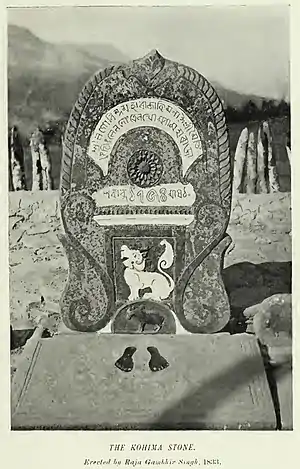Kohima Stone Inscription
The Kohima Stone Inscription (Meitei: Kohima Khut-ee Nungpak) or the Gambhir Singh's Stone (Meitei: Gambhir Singh Khut-ee Nungpak) is a Meitei language stone inscription, erected by Meitei King Raja Gambhir Singh (Meitei: Chinglen Nongdrenkhomba) of Manipur kingdom in Kohima (Meitei: Thibommei), the capital of Nagaland. It was erected in 1833 AD as a mark of Manipuri conquest and supremacy over the Naga Hills in 1832 AD. It was inscribed in sanskritised Manipuri language (Meitei language) in Bengali script. Manipuri King Raja Gambhir Singh (Meitei: Chinglen Nongdrenkhomba) conquered the whole Naga Hills with his military power of Manipur Levy. It was after he had finally defeated the Angami Nagas of Kohima that the historic testimonial stone inscription was erected.[1][2][3][4][5]
| Kohima Stone Inscription | |
|---|---|
| (Meitei: Kohima Khut-ee Nungpak) | |
 The Kohima Stone Inscription erected by Raja Gambhir Singh (Meitei: Chinglen Nongdrenkhomba) of Manipur Kingdom as the testimony of Meitei Dominance in Nagaland. | |
| Writing | Sanskritised Meitei language (in Bengali script) |
| Symbols | Kanglasha (dragon lion), a bull and footprint marks of King Raja Gambhir Singh (Meitei: Chinglen Nongdrenkhomba) |
| Created | 1833 AD |
| Discovered | Kohima, Nagaland |
| Present location | Nagaland State Museum, Kohima, Nagaland |
| Culture | Meitei culture |
History
Manipuri influence over the Naga ethnic groups declined during a period before and after the Burmese war of 1819-25. However, it was re-asserted during the time of Raja Gambhir Singh (Meitei: Chinglen Nongdrenkhomba). He reduced many ethnic villages, including Kohima, at which he stood upon the stone and had his footprints sculpted on it as a token of conquest. Kohima and its surrounding villages were the boundaries of Manipur. The Nagas greatly respected this stone and cleaned it from time to time[2][3][4]
Importance
The stone is so much important that it is frequently mentioned in many land laws and orders announced by the British Government of Naga Hills. One famous example is the Order of W.J. Williamson, a British Political Agent of Naga Hills on 19 April 1880.[6]
The stone inscription is notably mentioned in the "My Experiences in Manipur and the Naga hills" (1896) by Colonel Sir James Johnstone, the then Political Agent of Manipur,[4][7] and the The Meitheis (1908) written by Thomas Callan Hodson, the then Political Agent of Manipur.[8]
References
- Sanajaoba, Naorem (1988). Manipur, Past and Present: The Heritage and Ordeals of a Civilization. Mittal Publications. ISBN 978-81-7099-853-2. Archived from the original on 14 June 2022. Retrieved 14 June 2022.
- Sinha (Brigadier.), S. P. (2007). Lost Opportunities: 50 Years of Insurgency in the North-east and India's Response. Lancer Publishers. ISBN 978-81-7062-162-1. Archived from the original on 14 June 2022. Retrieved 14 June 2022.
- Singh, Dr Th Suresh (2 June 2014). The Endless Kabaw Valley: British Created Visious Cycle of Manipur, Burma and India. Quills Ink Publishing. ISBN 978-93-84318-00-0. Archived from the original on 14 June 2022. Retrieved 14 June 2022.
- Johnstone, James (23 May 2018). My Experiences in Manipur and the Naga Hills. BoD – Books on Demand. ISBN 978-3-7326-9966-7. Archived from the original on 14 June 2022. Retrieved 14 June 2022.
- Meitei, Sanjenbam Yaiphaba; Chaudhuri, Sarit K.; Arunkumar, M. C. (25 November 2020). The Cultural Heritage of Manipur. Routledge. ISBN 978-1-000-29637-2. Archived from the original on 14 June 2022. Retrieved 14 June 2022.
- Sharma, Suresh K. (2006). Documents on North-East India: Nagaland. Mittal Publications. ISBN 978-81-8324-095-6. Archived from the original on 14 June 2022. Retrieved 14 June 2022.
- Johnstone, James (1896). My experiences in Manipur and the Naga hills. University of California. London, S. Low, Marston and company, limited.
- Hodson, T. C. (Thomas Callan) (1908). The Meitheis. Duke University Libraries. London, D. Nutt.